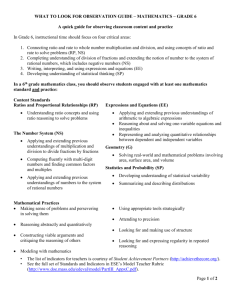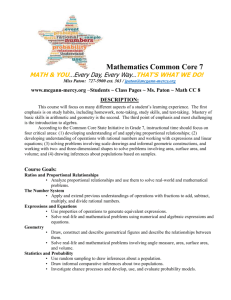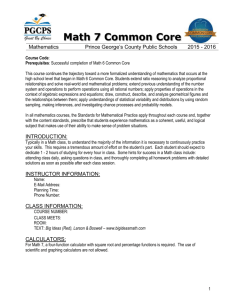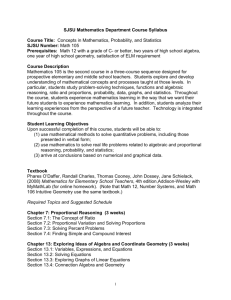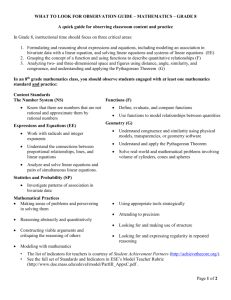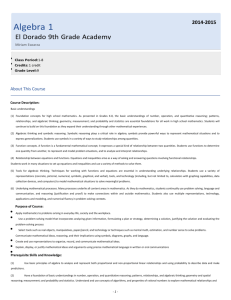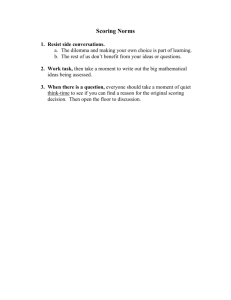What To Look For Math Grade 7
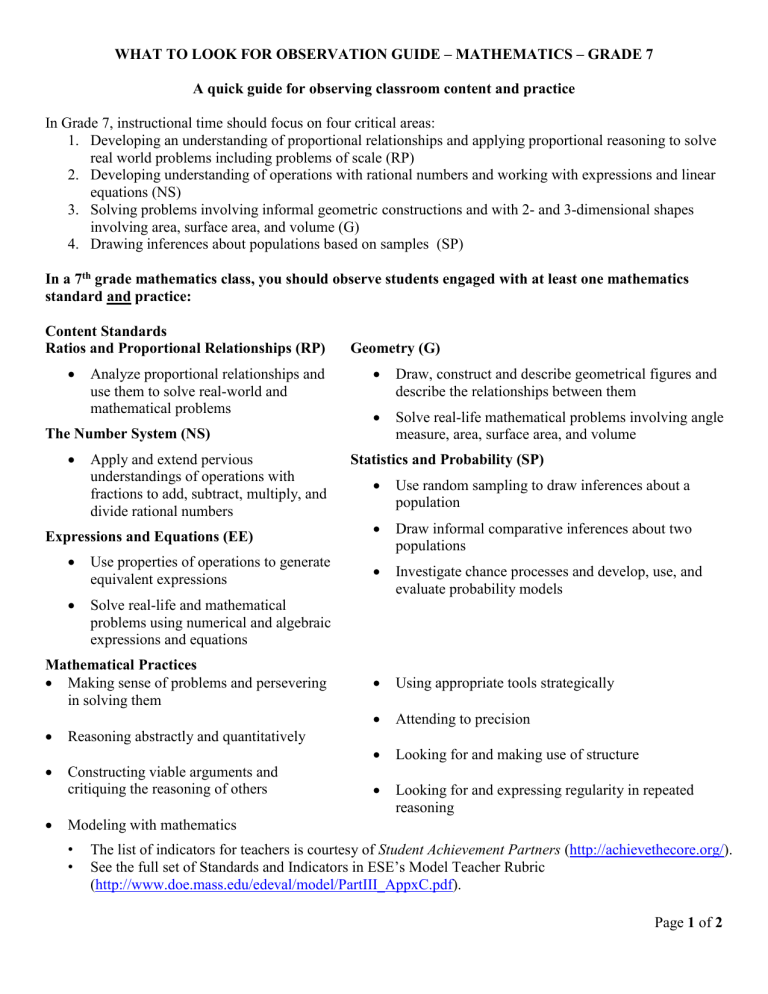
WHAT TO LOOK FOR OBSERVATION GUIDE – MATHEMATICS – GRADE 7
A quick guide for observing classroom content and practice
In Grade 7, instructional time should focus on four critical areas:
1.
Developing an understanding of proportional relationships and applying proportional reasoning to solve real world problems including problems of scale (RP)
2.
Developing understanding of operations with rational numbers and working with expressions and linear equations (NS)
3.
Solving problems involving informal geometric constructions and with 2- and 3-dimensional shapes involving area, surface area, and volume (G)
4.
Drawing inferences about populations based on samples (SP)
In a 7 th grade mathematics class, you should observe students engaged with at least one mathematics standard and practice:
Content Standards
Ratios and Proportional Relationships (RP) Geometry (G)
Analyze proportional relationships and use them to solve real-world and mathematical problems
Draw, construct and describe geometrical figures and describe the relationships between them
Solve real-life mathematical problems involving angle measure, area, surface area, and volume The Number System (NS)
Apply and extend pervious understandings of operations with fractions to add, subtract, multiply, and divide rational numbers
Expressions and Equations (EE)
Use properties of operations to generate equivalent expressions
Statistics and Probability (SP)
Use random sampling to draw inferences about a
Draw informal comparative inferences about two populations
population
Investigate chance processes and develop, use, and evaluate probability models
Solve real-life and mathematical problems using numerical and algebraic expressions and equations
Mathematical Practices
Making sense of problems and persevering in solving them
Reasoning abstractly and quantitatively
Constructing viable arguments and critiquing the reasoning of others
Modeling with mathematics
Using appropriate tools strategically
Attending to precision
Looking for and making use of structure
Looking for and expressing regularity in repeated reasoning
•
The list of indicators for teachers is courtesy of Student Achievement Partners ( http://achievethecore.org/ ).
•
See the full set of Standards and Indicators in ESE’s Model Teacher Rubric
( http://www.doe.mass.edu/edeval/model/PartIII_AppxC.pdf
).
Page 1 of 2
NOTES:
WHAT TO LOOK FOR OBSERVATION GUIDE – MATHEMATICS – GRADE 7
Mathematics What to Look For Guide
The practices below, which are aligned to the MA Model Teacher Rubric, should be evident in planning and instruction. Any particular lesson will demonstrate some of the practices, not all. For each lesson, artifacts or observables might include: lesson plan, tasks and assessments, teacher instruction, student discussion and behavior, or student work.
Standard I: Curriculum, Planning, and
Assessment (I-A, I-B)
The lesson focuses on grade-level cluster(s), content standard(s), or part(s) thereof.
The lesson intentionally targets the aspect(s) of rigor (conceptual understanding, procedural skill and fluency, and application) called for by the content and practice standard(s) being addressed.
Standard II: Teaching all Students (II-A)
The teacher poses high quality questions and problems, and provides time for students to develop and communicate their thinking about the content of the lesson.
The lesson includes clear explanations, representations, and/or examples to make the mathematics of the lesson explicit.
The lesson intentionally relates new learning to students’ prior skills and knowledge.
The lesson includes opportunities to monitor learning throughout the lesson (such as through questioning or performance on short problems).
The teacher uses variation in students’ ideas and solution methods to strengthen other students’ understanding.
The teacher addresses student variability and diverse needs (including English language learners and students with disabilities) to ensure equitable access to the lesson and achievement of the standard(s).
The teacher guides student thinking toward the focus of the lesson and references student work and discussion to summarize the mathematics learned.
Massachusetts Curriculum Framework
Page 2 of 2



